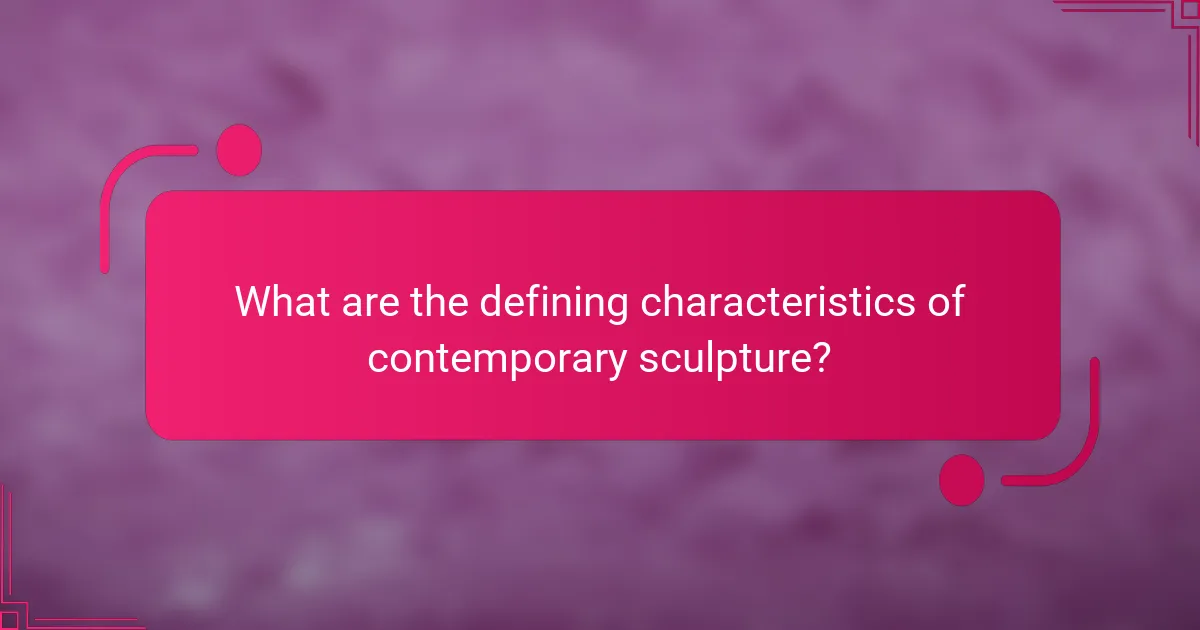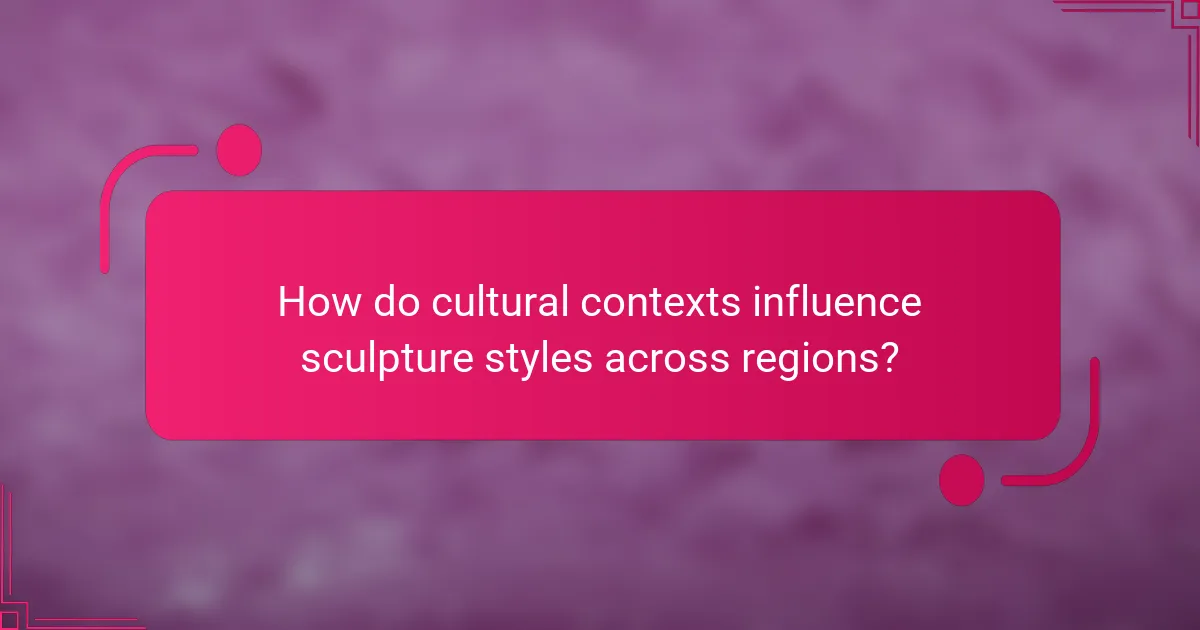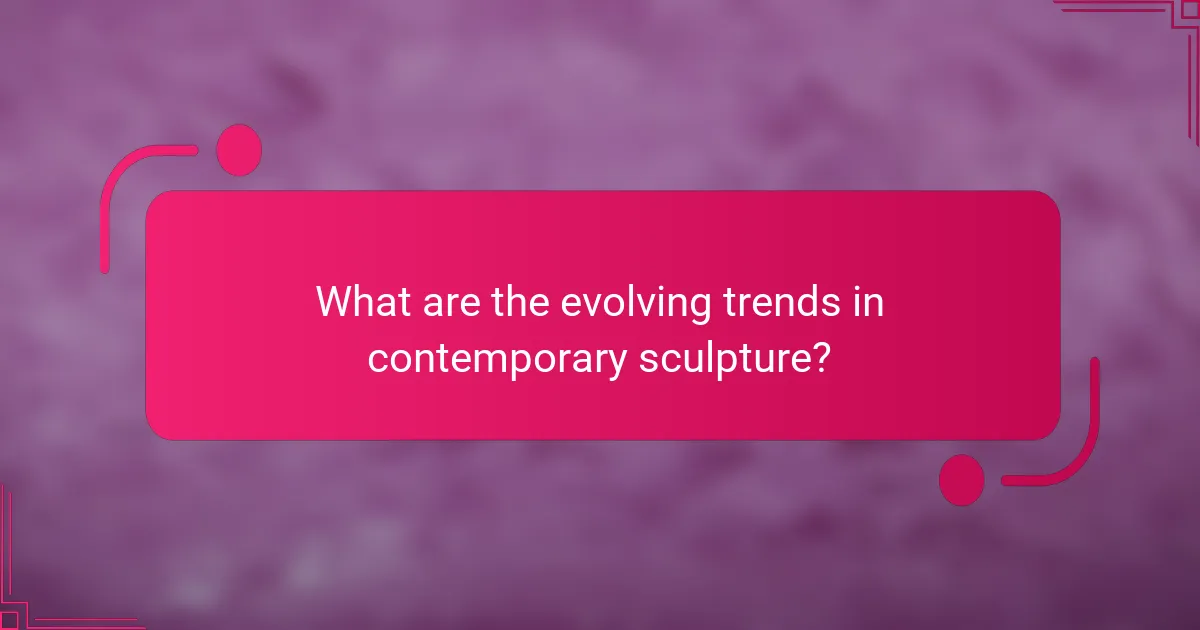Contemporary sculpture engages with diverse materials and innovative forms while addressing pressing social themes. This article explores various styles, notable works, and the cultural contexts that shape modern sculptures. It also examines how artists confront challenges related to funding, technology, and audience engagement. Iconic pieces like Anish Kapoor’s “Cloud Gate” and Jeff Koons’ “Balloon Dog” illustrate the dynamic landscape of contemporary art.

What are the defining characteristics of contemporary sculpture?
Contemporary sculpture is defined by its diverse materials, innovative forms, and engagement with social themes. Artists often utilize unconventional materials like found objects and digital media to challenge traditional boundaries. The exploration of identity, environment, and technology are prevalent themes, reflecting current societal issues. Iconic works, such as those by Damien Hirst and Anish Kapoor, exemplify these characteristics through their unique approaches and conceptual depth.
How does material choice influence contemporary sculpture?
Material choice significantly influences contemporary sculpture by affecting aesthetics, durability, and the conceptual message. Artists select materials that resonate with their themes, whether through traditional mediums like bronze or innovative options such as recycled plastics. For instance, the use of biodegradable materials can symbolize environmental consciousness. Unique attributes of materials, such as texture and color, also play crucial roles in viewer perception and engagement. The interaction between material and form can evoke emotional responses, making the choice of material a foundational aspect of contemporary sculptural practice.
What role does technology play in modern sculptural practices?
Technology significantly enhances modern sculptural practices by introducing innovative materials and techniques. Artists utilize digital tools for design, 3D printing, and augmented reality, expanding creative possibilities. For instance, CNC machines allow precise cutting of complex shapes, while virtual reality enables immersive experiences. These advancements foster collaboration across disciplines, pushing the boundaries of traditional sculpture. As a result, contemporary sculptures often blend physical and digital elements, creating unique interactions with the audience.

Which themes are prevalent in contemporary sculpture?
Contemporary sculpture often explores themes such as identity, technology, and environmental issues. Artists frequently challenge traditional forms and materials, incorporating mixed media and interactive elements. Notable works include installations that provoke social dialogue and reflect personal narratives. The integration of new technologies, like 3D printing, further expands the thematic landscape.
How do social and political issues shape sculptural expression?
Social and political issues significantly influence sculptural expression by reflecting societal values and challenges. Artists often respond to contemporary issues, using their works to provoke thought and inspire change. For instance, sculptures addressing climate change highlight environmental concerns, while pieces focused on social justice emphasize inequality. This engagement fosters dialogue and encourages viewers to reflect on pressing matters. Additionally, unique attributes of contemporary sculptures, such as interactive elements or the use of unconventional materials, enhance their impact by inviting audience participation. As a result, sculpture becomes a powerful medium for commentary and activism in today’s world.
What is the significance of environmental themes in modern sculpture?
Environmental themes in modern sculpture emphasize the relationship between art and nature. Artists use materials and concepts that reflect ecological concerns, promoting awareness of environmental issues. This practice often includes the use of sustainable materials, highlighting the impact of climate change. Sculptures may serve as a commentary on human interaction with the environment, encouraging viewers to reflect on their ecological footprint. By integrating natural elements, contemporary sculptures foster a dialogue about conservation and sustainability, making them significant in today’s art landscape.
![]()
What are some iconic works of contemporary sculpture?
Some iconic works of contemporary sculpture include “The Gates” by Christo and Jeanne-Claude, “Balloon Dog” by Jeff Koons, and “The Thinker” by Auguste Rodin. These pieces exemplify diverse styles and themes in contemporary art. “The Gates” features vibrant fabric installations in Central Park, while “Balloon Dog” showcases playful interpretations of everyday objects. “The Thinker,” though originally created in the 19th century, remains influential in modern discussions of sculpture. Other notable works include “Cloud Gate” by Anish Kapoor, known for its reflective surface, and “The Kiss” by Alberto Giacometti, which emphasizes human connection. Each work reflects unique artistic visions and cultural narratives.
Who are the leading sculptors of the 21st century?
Some leading sculptors of the 21st century include Ai Weiwei, Damien Hirst, and Anish Kapoor. Their works reflect contemporary themes and innovative styles. Ai Weiwei is known for his politically charged installations. Damien Hirst often explores concepts of life and death through his provocative pieces. Anish Kapoor’s sculptures are recognized for their monumental scale and reflective surfaces, challenging perceptions of space. Each artist contributes uniquely to the evolving landscape of contemporary sculpture.
Which sculptures have made a significant impact on public space?
Several sculptures have significantly impacted public space, transforming environments and influencing communities. Notable examples include “The Charging Bull” by Arturo Di Modica, symbolizing financial optimism in New York City, and “Cloud Gate” by Anish Kapoor, which reflects the skyline and engages visitors in Millennium Park, Chicago. “The Thinker” by Auguste Rodin invites contemplation in various locations worldwide, while “The Kiss” by Gustav Klimt, though originally a painting, has inspired numerous sculptures that evoke love and connection in public spaces. These works exemplify how sculpture can enhance urban landscapes and foster public interaction.

How do cultural contexts influence sculpture styles across regions?
Cultural contexts significantly shape sculpture styles, reflecting regional identities and values. For instance, African sculpture often emphasizes spiritual themes and communal values, while Western sculpture may focus on individualism and realism.
Materials and techniques also vary by culture. In Asia, traditional stone and wood carvings highlight craftsmanship and heritage, whereas contemporary Western sculptures frequently incorporate mixed media and technology.
The historical context further influences styles. Ancient civilizations like Greece and Rome celebrated human form and mythology, while modern movements, such as abstract expressionism, prioritize emotional expression over representational accuracy.
Iconic works, such as Michelangelo’s “David” and Rodin’s “The Thinker,” illustrate how cultural narratives and artistic movements converge to create distinct styles. Each region’s unique attributes contribute to a diverse global sculpture landscape.
What are the unique sculptural practices of specific regions?
Unique sculptural practices vary by region, reflecting cultural traditions and materials. In Africa, sculpture often emphasizes communal storytelling and spiritual beliefs, using wood and stone. Asian regions, particularly Japan, showcase intricate techniques in ceramics and bronze casting, emphasizing harmony with nature. In Latin America, indigenous cultures create vibrant sculptures that merge mythology with everyday life, often using local resources like clay and textiles. European contemporary sculpture frequently explores abstraction and installation, utilizing modern materials like metal and glass. Each region’s unique practices contribute to the global narrative of contemporary art.
How do local materials affect sculptural outcomes?
Local materials significantly influence sculptural outcomes by shaping texture, form, and cultural significance. Artists often select materials based on their availability and unique properties, which can enhance the narrative of the sculpture. For instance, clay from a specific region may reflect local traditions, while stone types can dictate the sculpting techniques used. The use of indigenous materials fosters a deeper connection to the environment and community, resulting in works that resonate more profoundly with viewers. Additionally, the physical characteristics of materials, such as durability and color, can affect the sculpture’s longevity and visual impact.

What are the evolving trends in contemporary sculpture?
Contemporary sculpture is increasingly characterized by innovative materials, interactive installations, and social commentary. Artists are blending traditional techniques with technology, such as 3D printing and augmented reality. Themes often explore identity, environment, and politics, reflecting global issues. Iconic works include Anish Kapoor’s “Cloud Gate” and Ai Weiwei’s installations, which provoke dialogue and challenge perceptions.
How is performance art intersecting with sculpture today?
Performance art is increasingly blending with sculpture, creating dynamic installations that challenge traditional boundaries. Artists use sculptural elements to enhance experiential engagement, often incorporating movement and audience interaction. This intersection highlights themes of temporality and physicality in contemporary art. Notable examples include works by artists like Ann Hamilton and Kiki Smith, who integrate multimedia elements into their sculptural practices, pushing the medium’s limits.
What innovations are emerging in sculptural techniques?
Innovations in sculptural techniques include 3D printing, augmented reality, and eco-friendly materials. Artists increasingly use these technologies to create intricate designs and engage audiences. 3D printing allows for precision and complexity, while augmented reality enhances viewer interaction. Eco-friendly materials reflect a growing commitment to sustainability in contemporary art.

Which challenges do contemporary sculptors face?
Contemporary sculptors face challenges such as funding limitations, evolving technology, and audience engagement. These factors can hinder artistic expression and accessibility.
Funding constraints often restrict materials and project scales. Evolving technology demands adaptation, as digital tools transform traditional practices. Engaging diverse audiences remains crucial, as sculptors seek relevance in a rapidly changing cultural landscape.
Additionally, the environmental impact of materials poses a unique challenge. Sculptors must consider sustainability while maintaining artistic integrity. Balancing innovation with tradition also creates tension in contemporary practices.
How do funding and support systems impact sculptural production?
Funding and support systems significantly influence sculptural production by providing resources and opportunities for artists. Financial backing enables the creation of large-scale works and experimental projects. Grants, sponsorships, and public art initiatives foster innovation and accessibility in sculpture. As a result, artists can explore diverse themes and materials, enhancing contemporary art’s richness.
What are the common misconceptions about contemporary sculpture?
Contemporary sculpture often faces misconceptions that can obscure its true nature. Many believe it lacks substance or is merely a form of decoration, while it actually engages deeply with social, political, and environmental themes. Another common myth is that contemporary sculpture is only about abstract forms; in reality, it encompasses a wide range of styles, including figurative and conceptual works. Additionally, some assume that contemporary sculptures are solely found in galleries, overlooking their presence in public spaces and urban environments, which enhance community engagement.
What best practices can sculptors adopt for successful exhibitions?
Sculptors can enhance their exhibition success by focusing on effective presentation, audience engagement, and strategic marketing. Strong visual presentation of sculptures is crucial; lighting and placement can significantly impact perception. Engaging the audience through interactive elements or artist talks fosters a deeper connection with the work. Additionally, leveraging social media and local art networks for promotion can increase visibility. Collaborating with other artists or institutions can also broaden reach and resources, creating a more dynamic exhibition experience.